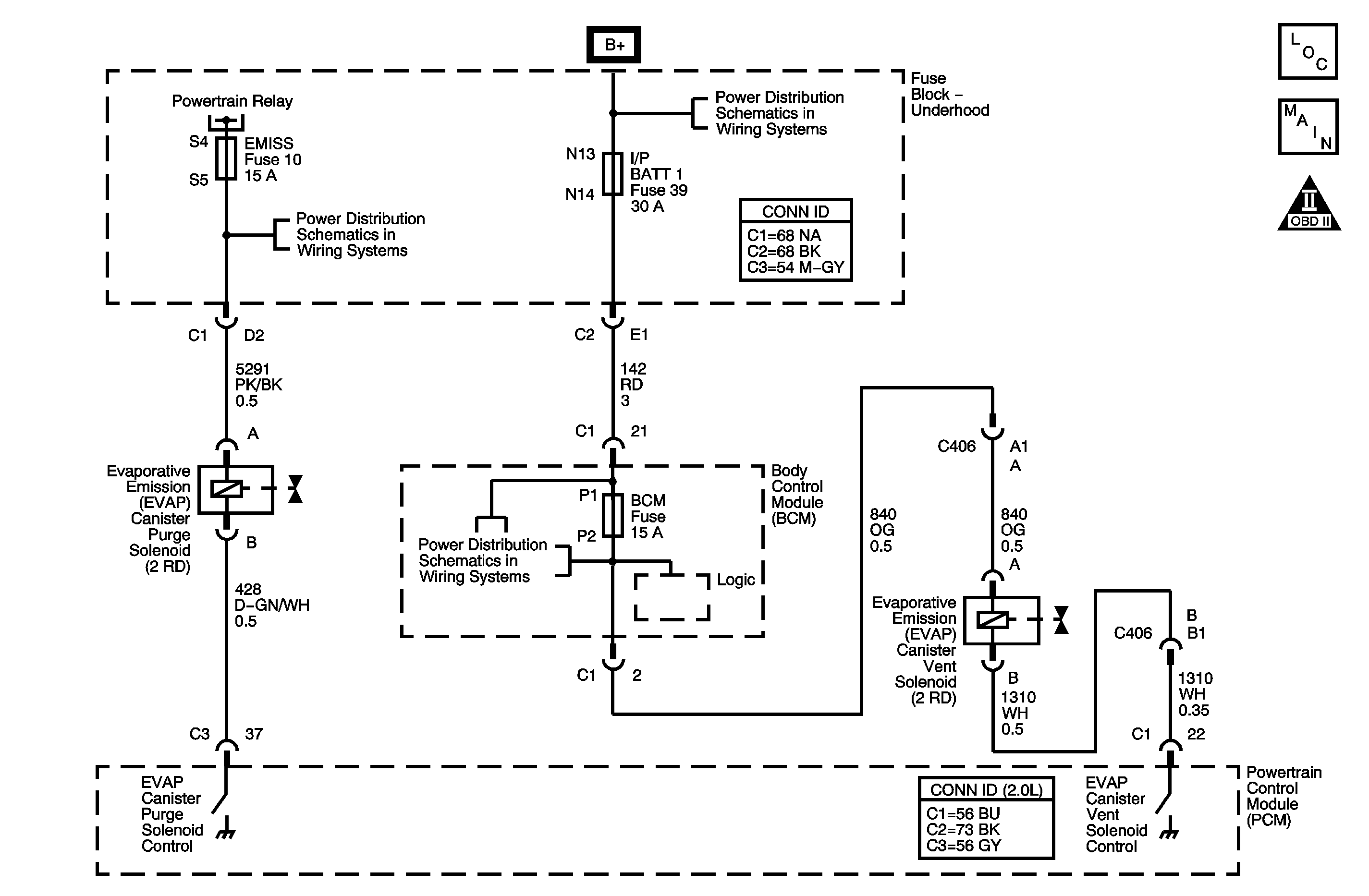
System Description
This DTC tests for undesired intake manifold vacuum flow to the evaporative emission (EVAP) system. The control module seals the EVAP system by commanding the EVAP canister purge solenoid valve Closed and the EVAP canister vent solenoid valve Closed. The control module monitors the fuel tank pressure (FTP) sensor to determine if a vacuum is being drawn on the EVAP system. If vacuum in the EVAP system is more than a predetermined value within a predetermined time, this DTC sets.
The following table illustrates the relationship between the ON and OFF states, and the Open or Closed states of the EVAP canister purge and vent solenoid valves.
Control Module Command | EVAP Canister Purge Solenoid Valve | EVAP Canister Vent Solenoid Valve |
|---|---|---|
ON | Open | Closed |
OFF | Closed | Open |
DTC Descriptor
This diagnostic supports the following DTC:
DTC P0496 Evaporative Emission (EVAP) System Flow During Non-Purge
Conditions for Running the DTC
| • | DTCs P0068, P0069, P0106, P0107, P0108, P0112, P0113, P0116, P0117, P0118, P0120, P0121, P0125, P0220, P0442, P0443, P0449, P0452, P0453, P0455, P0502, P2135, P2610 are not set. |
| • | The ignition voltage is between 11-18 volts. |
| • | The barometric pressure (BARO) is more than 74 kPa. |
| • | The fuel level is between 15-85 percent. |
| • | The start-up engine coolant temperature (ECT) is between 4-30°C (39-86°F). |
| • | The start-up intake air temperature (IAT) is between 4-30°C (39-86°F). |
| • | The start-up ECT and IAT are within 8°C (16°F) of each other. |
| • | DTC P0496 runs once per drive cycle when the above conditions are met. |
Conditions for Setting the DTC
The control module detects vacuum during a non-purge condition within 65 seconds of start-up.
Action Taken When the DTC Sets
| • | The control module illuminates the malfunction indicator lamp (MIL) on the second consecutive ignition cycle that the diagnostic runs and fails. |
| • | The control module records the operating conditions at the time the diagnostic fails. The first time the diagnostic fails, the control module stores this information in the Failure Records. If the diagnostic reports a failure on the second consecutive ignition cycle, the control module records the operating conditions at the time of the failure. The control module writes the operating conditions to the Freeze Frame and updates the Failure Records. |
Conditions for Clearing the MIL/DTC
| • | The control module turns OFF the malfunction indicator lamp (MIL) after 3 consecutive ignition cycles that the diagnostic runs and does not fail. |
| • | A current DTC, Last Test Failed, clears when the diagnostic runs and passes. |
| • | A history DTC clears after 40 consecutive warm-up cycles, if no failures are reported by this or any other emission related diagnostic. |
| • | Clear the MIL and the DTC with a scan tool. |
Step | Action | Values | Yes | No |
|---|---|---|---|---|
Schematic Reference: Evaporative Emissions Hose Routing Diagram | ||||
1 | Did you perform the Diagnostic System Check - Vehicle? | -- | Go to Step 2 | Go to Diagnostic System Check - Vehicle in Vehicle DTC Information |
2 |
Is the fuel tank pressure sensor parameter within the specified value? | -1 to +1 H2O | Go to Intermittent Conditions | Go to Step 3 |
3 |
Is the fuel tank pressure sensor parameter within the specified range? | -1 to +1 H2O | Go to Step 4 | Go to Step 5 |
4 | Replace the EVAP canister purge solenoid valve. Refer to Evaporative Emission Canister Purge Solenoid Valve Replacement . Did you complete the replacement? | -- | Go to Step 6 | -- |
5 | Replace the FTP sensor. Refer to Fuel Tank Pressure Sensor Replacement . Did you complete the replacement? | -- | Go to Step 6 | -- |
6 |
Is the fuel tank pressure sensor parameter within the specified range? | -1 to +1 H2O | Go to Step 7 | Go to Step 2 |
7 | Observe the Capture Info with a scan tool. Are there any DTCs that have not been diagnosed? | -- | Go to Diagnostic Trouble Code (DTC) List - Vehicle in Vehicle DTC Information | System OK |
